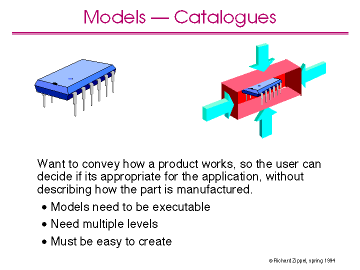
Back to the previous slide, on to the next slide or up to the communications overview
The metaphor of electronic models also works well in other domains. In electronic commerce, vendors describe and publicize their products so that potential customers can choose to purchase them. The customers will only purchase products when they are convinced the products will satisfy their needs, so the vendors are encouraged to reveal as much information abou the products as possible. On the other hand, the vendors want to reveal as little about the product as possible, since these commitments preclude future modifications and cost savings. Furthermore, the vendors want to avoid reveal any data that would allow a competitor to duplicate the product. Thus both the vendors and customers want to deal with electronic models of products of products.
Today, most of these models are provided by catalogues. The catalogue provides the customer with some information about the product, but not that much. The customer would prefer a model that could be carefully examined in the context where it will be used. Today this is why mail order firms are tend to be rather flexible with returned merchandise -- it allows the customer to examine the product at home, where it will be used. It would be better if a model of set of towels could be examined -- color compared with that of the bathroom where they will be used, their feel and absorbency examined. This approach was tried in the late 1980's by Buick, who made available electronic models of a new car which would allow you to ``experience'' how it handled.
In order for these models to interact with the customer's environment it must be possible to create executable versions of these models. And it must be easy to create these models. One area where we believe we have a handle on this problem is models of physical systems.
Richard Zippel